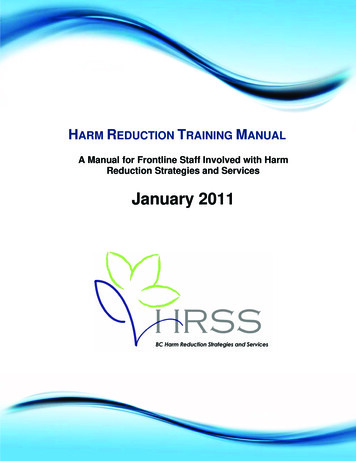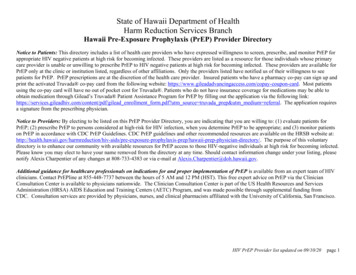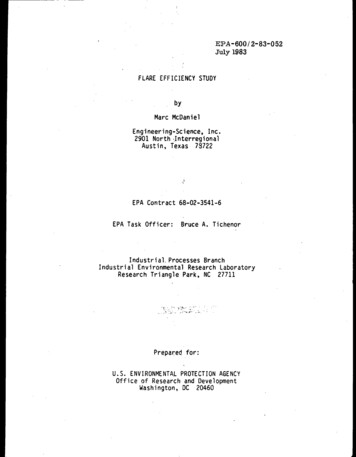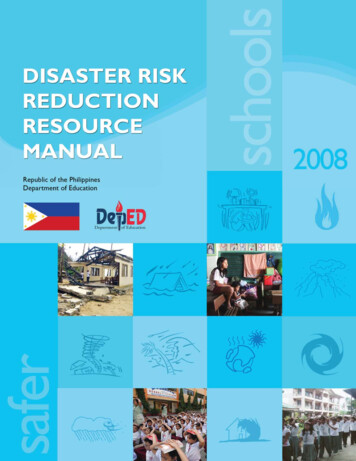
Transcription
HARM REDUCTION TRAINING MANUALA Manual for Frontline Staff Involved with HarmReduction Strategies and ServicesJanuary 2011
i) Letter to ReaderThis manual has been provided as a tool to assist you in your service to help reduce theharms associated with drug use to individuals, families and within your community. Weencourage using and sharing these tools and information provided to promote growth in theknowledge and understanding of harm reduction within your communities. Harm reductioncontinuously changes and we encourage you to follow the web links provided to remain up todate on the changes, information, policies, and forms.ii) Current/ updated informationThe latest:BC Harm Reduction Strategies and Services Policy and GuidelinesHarm Reduction Program: Supply Requisition FormCan be found fault.htmHealth link BC – Health files can be accessed mNote about footers and updates: Footer dates will only be changed on those pagesthat have been amended; all other footers will remain unchanged.Pages to be removed and replaced along with date of modification will be recordedon the last page of the manual.Updated January 2011
TABLE OF CONTENTSINTRODUCTION .41. HARM REDUCTION .5DEFINITIONS OF HARM REDUCTION.5GUIDING PRINCIPLES OF HARM REDUCTION .5HARM REDUCTION IN CANADA AND INTERNATIONALLY .42. INFECTIONS .7HIV/AIDS .8HEPATITIS .8SEXUALLY TRANSMITTED INFECTIONS .9Chlamydia .9Genital Herpes .9Gonorrhea .9Human Papillomavirus (HPV) .10Syphilis.103. DRUG EFFECTS.124. SAFER SUBSTANCE USE.155. MENTAL HEALTH .186. WORKING WITH INDIVIDUALS.18PERSONAL VALUES, ATTITUDES AND MISCONCEPTIONS .19INDIVIDUAL ENGAGEMENT STRATEGIES .19RESPONDING TO A HISTORY OF ABUSE .20FAMILIES, INDIVIDUAL AND COMMUNITY.20ABORIGINAL COMMUNITIES .22REFERRING CLIENTS TO OTHER SERVICES .22ADVOCATING FOR CLIENTS.23YOUTH .23LESBIAN, GAY, TRANSGENDERED, BISEXUAL, QUEER (LGTBQ) .237. APPENDICES .231. HARM REDUCTIONHarm Reduction: History of Harm Reduction in British Columbia1A: Harm Reduction Definitions, Reducing Harm: Treatment and Beyond. Four Pillars DrugStrategy1B: Harm Reduction: A British Columbia Community Guide1C: Harm Reduction health files #102a#102b1D: BC Harm Reduction Strategies and Services Policy and Guidelines1E: BC Harm Reduction Strategy and Services (HRSS) CommitteePrimary, Secondary and One-off Distribution Site Policy1F: Strategies – Harm Reduction Strategies and Services newsletters2. INFECTIONS (BC health files #)2A: HIV/AIDS #08m2B: Hepatitis A vaccine #33; hepatitis B vaccine #25a; hepatitis C virus #40a; Living wellwith hepatitis C infection #40b2C: Chlamydia #08l2D: Genital Herpes #08dUpdated January 2011
2E: Gonorrhea #08a2F: Human Papillomavirus (HPV) #101a2G: Syphilis #08e3. DRUG EFFECTS3A: Street Definitions4. SAFER SUBSTANCE USE4A: Harm Reduction Program: Supply Requisition Form4B: Harm Reduction Supply Ordering at the BCCDC4C: Rationale for crack pipe mouthpiece distributionQuestions and Answers: Female condoms Sterile water Cookers and Injection Drug Use Stericup cooker: Cooker instructions Acidifier (Ascorbic acid) and Injection Drug Use Crack pipe push sticks Crack pipe mouthpieces4D: More than just needles: an evidence –informed approach to enhancing harm reductionsupply distribution in British Columbia4E: Best Practices for British Columbia Harm Reduction Supply Distribution Program(September 2008)4F: Harm Reduction Learning Series Pamphlets6. WORKING WITH INDIVIDUALSABORIGINAL6A: Walk With Me: Pathways to Health; Harm Reduction Service Delivery Model6B: Community Readiness: A Handbook for Successful Change: Please download fromwebsiteLESBIAN, GAY, TRANSGENDER, BISEXUAL AND QUEER6C: List of Suggested Readings6D: Glossary of Terms7. ACTIVITY AND ENGAGEMENT EXCERCISES7A: Client engagement / role play activity7B: 5-min elevator pitch7C: Peer engagement: benefits and challenges activity8. RESOURCESUpdated January 2011
IntroductionThe purpose of this manual is to build on the knowledge, skills, and attitudes necessary to maximize thedistribution of products to reduce harms associated with substance use; and to engage, educate, andadvocate for individuals. The manual outlines and encourages the use of best practice to colleagues andpeers within their specific agencies and organizations. It provides a reference to what support andtreatment resources are available to which they can refer individuals. Specifically frontline staff will beable to use the manual as a guide and reference tool for: Individual engagement Encourage and support needle collection and return (at the individual and community levels) Inform individuals about reducing risks of blood borne pathogen transmission, and safer drugusing and sexual practices Engage with individuals to provide effective education regarding harm reduction practicesassociated with routes of use, substances used, and social use practices. Respond to individuals who report a history of past or recent trauma, abuse or violence Refer individuals (e.g. social services, housing, addiction and mental health treatment) Advocate for individuals Respond to community pressures and concerns.Updated February 20104
1. Harm ReductionAt the end of this section, you will be able to explain: Definition for harm reductionEveryday examples of harm reductions interventions.The guiding principles of harm reductionThe history of harm reduction within Vancouver and globallyIt is important to acknowledge that harm reduction is not a new concept. Harm reduction principles havebeen applied for many decades in many areas outside the field of addiction. Day to day strategies suchas using a seatbelt while driving a car, wearing sunglasses while outside, or using hand rails whenwalking down stairs are all examples of an intervention to help reduce harm. What are some examples of harm reduction strategies that you use in your everyday life?Definitions of Harm ReductionHarm reduction has a variety of meanings to different people, which has made developing one generaldefinition very difficult. Regardless of the definition, harm reduction is a philosophy, approach, and a setof principles that combined help achieve certain social and political goals. As per the BC Harm ReductionStrategies and Services Policy and Guidelines:Harm reduction involves taking action through policy and programming to reduce theharmful effects of behaviour. It involves a range of non-judgmental approaches andstrategies aimed at providing and enhancing the knowledge, skills resources andsupports for individuals, their families and communities to make informed decisions to besafer and healthier.For further definitions of Harm Reduction and Reducing Harms: Treatment and Beyond see Appendix 1A.Guiding Principles of Harm ReductionThe principles of harm reduction as outlined in the Harm Reduction: British Columbia Community Guide(2005) (Appendix 1B) are summarized below.PRAGMATISM - Harm reduction recognizes that drug use is a complex and multi-facetedphenomenon that encompasses a continuum of behaviors from abstinence to chronicdependence and produces varying degrees of social harm. Harm reduction accepts that the nonmedical use of psychoactive or mood altering substances is a universal phenomenon. Itacknowledges that, while carrying risks, drug use also provides the user and society with benefitsthat must be taken into account.HUMAN RIGHTS - Harm reduction respects the basic human dignity and rights of people whouse drugs. It accepts the drug user’s decision to use drug and no judgment is made either tocondemn or support the use of drugs. Harm reduction acknowledges an individual drug user’sright to self-determination and supports informed decision making in the context of active druguse.Emphasis is placed on personal choice, responsibility and management.Updated February 20105
FOCUS ON HARMS - The fact or extent of an individual’s drug use is secondary to the harmsfrom drug use. The priority is to decrease the negative consequences of drug use to the user andothers, rather than decrease drug use itself. While harm reduction emphasizes a change to saferpractices and patterns of drug use, it recognizes the need for strategies at all stages along thecontinuum of drug use.MAXIMIZE INTERVENTION OPTIONS - Harm reduction recognizes that people who use drugsbenefit from a variety of different approaches. There is no one prevention or treatment approachthat works reliably for everyone. It is providing options and prompt access to a broad range ofinterventions that helps keep people alive and safe. Individuals and communities affected bydrug use need to be involved in the creation of effective harm reduction strategies.PRIORITY OF IMMEDIATE GOALS - Harm reduction starts with “where the person is” in theirdrug use, with the immediate focus on the most pressing needs. It establishes a hierarchy ofachievable interventions that taken one at a time can lead to a fuller, healthier life for drug usersand a safer, healthier community. Harm reduction is based on the importance of incrementalgains that can be built on over time.DRUG USER INVOLVEMENT - Harm reduction acknowledges that people who use drugs are thebest source for information about their own drug use, and need to be empowered to join theservice providers to determine the best interventions to reduce harms from drug use. Harmreduction recognizes the competency of drug users to make choices and change their lives. Theactive participation of drug users is at the heart of harm reduction.For further information on harm reduction and its benefits refer to Appendix 1C: Harm Reduction HealthFile #102a Understanding Harm Reduction and File #102b Harm Reduction for Families and Caregivers.Harm Reduction in Canada and InternationallyHarm reduction started in Merseyside, England in the mid-1980s. As a result of the increasingly obviousconnection between injecting drug use and the rise of HIV and hepatitis C virus (HCV) infections, harmreduction initiatives started emerging in Canada in the late 1980’s with the establishment of needleexchanges, methadone maintenance and sexual health education programs. Needle exchanges,supported by provincial policy, began in BC in 1988.During the 1990s in Vancouver, the drug market underwent a significant shift. Cocaine became availablein large amounts which coincided with the increase of individuals with low incomes and mental illness inthe Downtown Eastside (Kerr, Woods, 2006). In 1997, the local health authority in Vancouver declared apublic health emergency when the rate of HIV infections became the highest in the Western World alongwith the rise in HCV infections.Today, the prevalence of drug use and persons who use drugs in Vancouver’s downtown eastside putsharm reduction in the forefront of health related issues. As a result, BC is seen as a leader within theNorth American context but looks internationally to research outcomes of harm reduction where harmreduction strategies are more developed.Since 2004 the BC Centre for Disease Control has tracked the distribution of products funded by theprovincial government and subsidized by Provincial Health Service Authority to reduce drug-relatedharms. These products include needles and syringes, sterile water, alcohol swabs, male condoms:lubricated, non-lubricated and flavoured; female condoms, and lubricant. Supplies can be ordereddirectly by sites which have been approved by the health authority (primary sites); smaller quantities ofsupplies or supplies for special events may be collected from a primary site by prior arrangement.Updated January 20116
In November 2008 BC switched to a single source distributor so that all supplies are available from onesite. The supply requisition forms (Appendix 4A) should be faxed to BCCDC where they are processedweekly (on Fridays) and sent to the distributor. The distributor has committed to having 3-months suppliesin stock. Where possible sites are requested to order in bulk every 3 months to avoid handling fees forsmall orders. For Supply order details see Appendix 4B.The British Columbia Harm Reduction Strategies and Services (HRSS) Committee provides the structureto facilitate coordination of evidence based harm reduction strategies and services. The BC HarmReduction Strategies and Services Policy and Guidelines (2009) is found in Appendix 1D. Furtherinformation on harm reduction practices can be found in the resource section of this manual.“Harm Reduction” works in cooperation with prevention, treatment and enforcement. It does not exist inisolation nor exclude prevention, treatment and enforcement. Harm reduction acknowledges theimportance of prevention, treatment and enforcement ‘pillars’ and the need to work together to reduceharms related to illegal drug use. Vancouver’s harm reduction strategies are based on the Four PillarsDrug Strategy approach. For more information refer to Appendix 1A: Vancouver Four Pillars DrugStrategy, Appendix 1F: Harm Reduction Strategies and Services newsletter What are some Harm Reduction strategies you have seen implemented in yourarea of work?2. INFECTIONSAt the end of this section, you will be able to explain: The link between harm reduction strategies and the transmission of infections Routes of transmission for infections How to talk about safer sex with clientsInfections are microorganisms such as viruses or bacteria that can cause disease in people. There aremany different pathogens but we will focus on hepatitis A, B and C, Human Immunodeficiency Virus (HIV)and other sexually transmitted infections (STI). Pathogens such as hepatitis B virus (HBV) and HIV canbe transmitted through contact with infected human blood and other potentially infectious body fluids suchas:o Semeno Vaginal secretionso Cerebrospinal fluido Synovial fluido Pleural fluido Peritoneal fluido Amniotic fluido Saliva (in dental procedures), ando Any body fluid that is visibly contaminated with blood.The goal of harm reduction in the context of drug use is to reduce the harms, such as transmission ofinfections, associated with the behaviour. This may be achieved by prevention through education aroundsafer sex practices and safer substance use, and by providing relevant supplies. There are variousroutes of transmission of infections therefore harm reduction approaches must be varied and at timesused simultaneously.Updated January 20117
HIV/AIDSHIV is the virus that causes Acquired Immunodeficiency Syndrome (AIDS). HIV attacks the immunesystem, resulting in a chronic, progressive illness which leaves infected people vulnerable to opportunisticinfections and cancer. HIV can be transmitted by unprotected sexual intercourse (vaginal, anal, oral);shared needles or equipment for injecting drugs; unsterilized needles for tattooing, skin piercing;pregnancy, delivery and breast feeding (from an HIV-infected mother to her infant); and occupationalexposure in health care settings. See Appendix 2A: HIV health file # 08mHepatitisHepatitis, is inflammation of the liver, and may be caused by a virus such as hepatitis A, hepatitis B andhepatitis C. Chronic hepatitis may cause permanent liver damage, scarring, cirrhosis of the liver, livercancer and liver failure. Approximately 40,000 cases of chronic hepatitis B and 60,000 cases of hepatitisC have been identified in BC since early 1990’s; rates of infection in BC are higher than the nationalaverage. Effective vaccines are available to prevent hepatitis A and B (See health files #33 and #25a).There is no vaccine for hepatitis C.Hepatitis A virus (HAV) can be transmitted from the feces of an infected person through oral-anal sex.HAV causes an acute infection lasting from a few weeks to several months. It does not lead to chronicinfection. Outbreaks of HAV have occurred amongst individuals who use intravenous drugs; transmissionmay be related to poor hygiene and sharing drugs, syringes, and drug preparation equipment. HAV alsocan be transmitted through poor food handling such as eating food or drinking water that has beencontaminated with fecal matter containing the virus.Hepatitis B virus (HBV) is transmitted through contact with blood or other body fluids (i.e. semen andvaginal fluid) of an infected person. Modes of transmission are sexual contact, unsafe injections practices;close interpersonal contact with infected household contacts, perinatal (from mother to baby at birth) andblood transfusions. HBV is not spread by casual contact. HBV chronic infection is inversely related to theage at infection; 90% infants and 5-10% adults remain chronically infected.Hepatitis C virus (HCV) is transmitted mainly by blood-to-blood contact. Sharing needles, syringes andother drug-use equipment is the most common way of transmitting HCV. Some British Columbians wereinfected with HCV before 1990, through blood products received before reliable tests to identify the virusin blood donors were available. Most people have no symptoms and therefore are unaware when theyare infected with HCV. About 10% of people have a brief illness with symptoms of hepatitis: fever,tiredness, loss of appetite, nausea, jaundice (yellow skin or eyes), abdominal pain, and dark urine 6 - 9weeks after they have been infected. The majority of people infected (70-85%) do not clear the virus andbecome chronically infected with HCV. They may experience long-term health concerns, such astiredness, lack of energy, or digestive problems and liver damage (cirrhosis). See appendix 2B: HepatitisC health files #40a and 40bPrevention StrategiesHepatitis A and B vaccines are effective in preventing infection and are free for people who inject illegaldrugs and those who have HCV.HAV vaccine is given as a series of two shots with the second dose given at least 6 months after thefirst. The vaccine provides excellent protection against HAV in persons over six months of age.Updated February 20108
People eligible to receive free HAV vaccine include:oooPeople who use illegal drugs by needle;People who have hepatitis C;Men who have sex with menHBV vaccination series (usually 3 shots) is provided free at local health units for:o Household members and sexual partners of someone who has hepatitis B;o Sexually active homosexual or bisexual males;o Individuals who inject illegal drugs by needle or a sexual partner of an individual who does;o Individuals who have many sex partners or have a recent history of a sexually transmitteddisease; or have hepatitis C.Avoid sharing needles or other equipment used for injecting, snorting or smoking drugs; and avoidsharing household items which may be contaminated with blood such as razors and toothbrushes.Sexually Transmitted InfectionsThe term Sexually Transmitted Infection (STI) is now commonly used in the place of STD (SexuallyTransmitted Disease). STIs are generally transmitted through various forms of sexual contact or activity.Some of the most common STIs are chlamydia, genital herpes, gonorrhea, human papillomavirus (HPV)and syphilis.Chlamydia - is a sexually transmitted bacterium that infects the urethra, the cervix and the rectum. Thebacteria, Chlamydia Trachomatis (CT) is passed between people by direct contact with infected sexualfluids from the genitals. Actual penetration is not necessary for the bacteria to be transmitted. Closecontact of a penis and vagina, prior to condom use, or masturbation with the sexual fluids may transmitthe bacteria if one partner has the infection. If the bacteria is rubbed into the eye, it is possible to get aneye infection (conjunctivitis). See Appendix 2C: Chlamydia health file #08lGenital Herpes - Herpes is the common name for two viruses - Herpes Simplex Type 1 and HerpesSimplex Type 2. Herpes can affect mouth/face, genital and/or rectal area. It used to be thought thatHerpes Simplex Type 1 caused sores and blisters on the mouth or face whereas Herpes Simplex Type 2caused these same symptoms in the genital and/or rectal area. It's now known that Herpes Simplex Type1 can spread to the genital and rectal area and Herpes Simplex Type 2 to the face and mouth.Herpes is incurable and once a person is infected with the virus they will have it for life and mayperiodically experience symptoms associated with it. The herpes virus is spread by skin-to-skin contacteither genital to genital or face/mouth to genital (oral sex). Symptoms do not need to be present for thevirus to be passed from one person to another. In fact, the herpes virus can be inactive or latent for longperiods of time.For this reason many people who have Herpes never realize it, and most people who pass it on tosomeone else are unaware of their infection at the time. This is called asymptomatic shedding. The goodnews is that over 95% of the time herpes can be detected when the virus is active allowing the person toavoid exposing a partner. For more information refer to Appendix 2D: Genital herpes health file #08d.Gonorrhea - is a sexually transmitted infection that can infect the urethra, cervix, throat and rectum. Abacterium called Neisseria Gonorrhoeae causes these infections. Also known as: GC, "Clap", VD, "Drip."Gonorrhea is spread between people by direct contact with the infected sexual fluids from anotherperson. These fluids are not always seen. Gonorrhea can be spread from an infected person's throat to apenis and vice versa, but not when oral sex is performed on a woman.Updated January 20119
Penetration or ejaculation is not necessary for gonorrhea to be transmitted. Close contact, like touchingbefore condom use, or masturbation with the sexual fluids of an infected person can transmit the bacteriafrom one person to another.It is also possible, though not common, to transmit the bacteria by your hands or fingers. For example,touching infected sexual fluids then rubbing an eye could result in an eye infection known asconjunctivitis. For more information refer to Appendix 2E: Gonorrhea health file #08aHuman Papillomavirus (HPV) - is one of the most common causes of STIs in the world. Scientists haveidentified more than 100 types of HPV, most of which are harmless. About 30 types are spread throughsexual contact. Some types of HPV cause genital warts and some can cause cervical cancer and othergenital cancers. Any person who is sexually active can get genital warts. Genital warts can be transmittedby direct skin to skin contact during vaginal and anal sex. Oral transmission of this virus is extremely rare.Warts on other parts of the body, such as the hand and feet, are caused by a different type of wart virus.These warts cannot be spread can be spread to the genital area. For more information refer to Appendix2F: Human Papillomavirus (HPV) health file #101aSyphilis - is an infection with the bacterium Treponema pallidum from the spirochete family. Symptomsfor syphilis come in stages and vary from person to person. It is also known as the great imitator since itappears to be like many other diseases and is difficult to diagnose. Syphilis is most commonly transmittedthrough sexual activity, including penis to vagina, penis to mouth, penis to rectum and mouth to vagina.For more information refer to Appendix 2G: Syphilis health file #08e.How to talk about safer sex with clientsTalking about sex is often difficult, it is important for workers to find ways to discuss safer sex practicesmore openly with individuals. It is helpful to speak with individuals using terms they will understand andacknowledge that they may find the discussion difficult. When talking about sex it is essential to considerthe individuals experience, understanding and beliefs about sex.Safe sex practicesSafe sex means not allowing your partner's body fluids (blood, semen, vaginal fluids) into your body. Itcan also mean covering up or avoiding contact with parts of the body that might be infectious (e.g. herpessores or warts). Condoms are most commonly used in safe sex practice to reduce the risk oftransmission of infectious diseases such as HIV and various STI’s. There are male and female condoms;Male condoms - latex condoms are the most common barrier used for safe sex. Mostf condom failures isnot due to the condom, but because people using the condom didn't put it on correctly. Please review thesteps below.ooooOpen the condom wrapper carefully; keeping in mind condoms can be torn by fingernails andsharp objects such as jewelry, zips and buckles. Only put on condom after there is a partial or fullerection.Air trapped inside a condom can cause it to break. Squeeze the tip of the condom with yourfingertips to leave some extra space in the tip, and put on condom, rolling the entire condomdown to the base of the penis, still pinching the top. Be sure that the roll is on the outside.Make sure the condom stays in place during sex; if it rolls up, roll it back into place immediately. Ifthe condom comes off, withdraw the penis and put on a new condom.Soon after ejaculation - or when sex is finished - withdraw the penis while it is still erect, makingsure to hold the condom firmly in place. Remove the condom only once the penis is fullyUpdated February 201010
withdrawn. Dispose of the used condom hygienically. Wrap the condom in a tissue and place it in thetrash. Don't flush it down the toilet.Female condoms – are not as commonly used as the male condom but are just as effective. The femalecondom is a tube made of thin polyurethane plastic or rubber. It is closed at one end, and designed toform a loose lining to a woman's vagina with two flexible rings, one at each end, to keep it in place. Thering in the closed end fits inside the vagina, just behind the pubic bone. The ring at the open end staysoutside the vagina, lying flat against the area around the entrance to the women’s vaginaHow to put on a female condom:o Open the package carefully. Choose a position that is comfortable for insertion - squat, raiseone leg, sit or lie down. Make sure the condom is lubricated enough.o Make sure the inner ring is at the closed end of the sheath, and hold the sheath with the openend hanging down. Squeeze the inner ring with thumb and middle finger (so it becomes longand narrow), and then insert the inner ring and sheath into the vaginal opening. Gently insertthe inner ring into the vagina and feel it go up. Place the index finger inside the condom andpush the inner ring as far as it will go. Make sure the condom is inserted straight, and is nottwisted inside the vagina. The outer ring should remain on the outside of the vagina.o The penis should be guided into the condom in order to ensure that the penis does not slipinto the vagina outside the condom. Use enough lubricant so that the condom stays in placeduring sex. The female condom should not be used at the same time as a male condombecause the friction between the two condoms may cause the condoms to break.o If the condom slips during intercourse, or if it enters the vagina, then you should stopimmediately and take the female condom out. Then insert a new one and add extra lubricantto the opening of the sheath or on the penis.o To remove the condom, twist the outer ring or frame gently and then pull the condom
Updated February 2010 5 1. Harm Reduction At the end of this section, you will be able to explain: Definition for harm reduction Everyday examples of harm reductions interventions. The guiding principles of harm reduction The history of harm reduction within Vancouver and globally It is important










